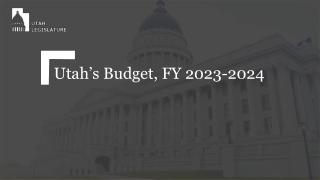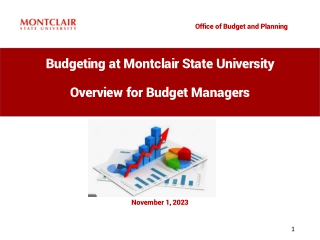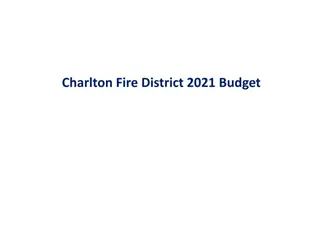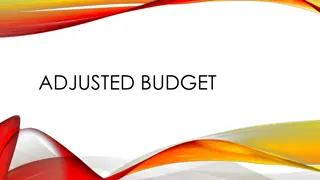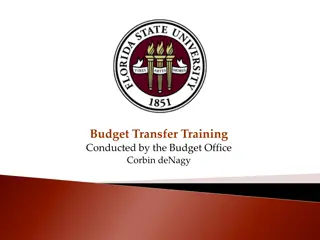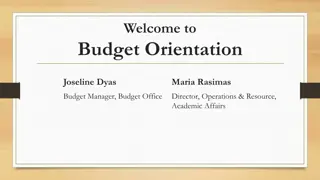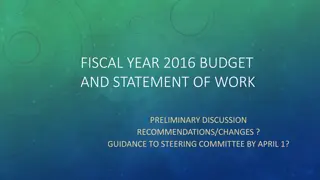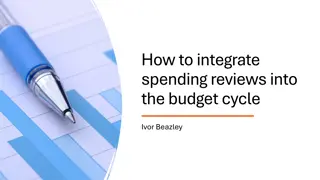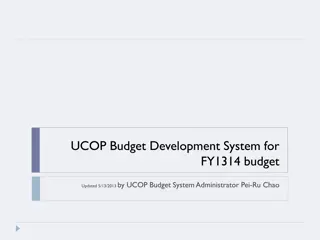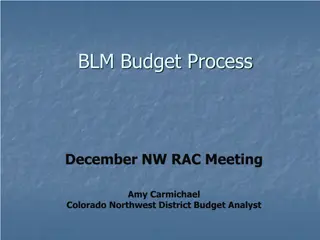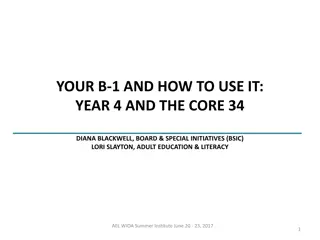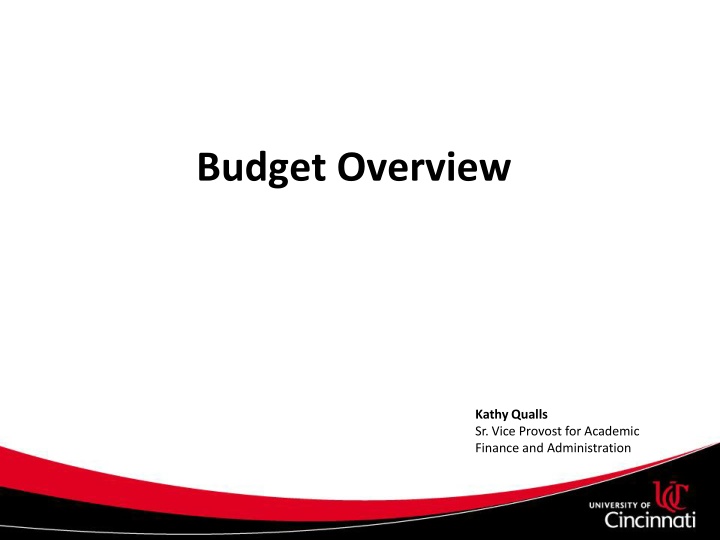
Budget Overview
Explore University budgeting processes, annual budgets, and how budgets are built (bottom-up vs. top-down). Learn about incremental budgeting at UC, budget drivers, and responsibilities in managing budgets effectively.
Download Presentation

Please find below an Image/Link to download the presentation.
The content on the website is provided AS IS for your information and personal use only. It may not be sold, licensed, or shared on other websites without obtaining consent from the author. If you encounter any issues during the download, it is possible that the publisher has removed the file from their server.
You are allowed to download the files provided on this website for personal or commercial use, subject to the condition that they are used lawfully. All files are the property of their respective owners.
The content on the website is provided AS IS for your information and personal use only. It may not be sold, licensed, or shared on other websites without obtaining consent from the author.
E N D
Presentation Transcript
Budget Overview Kathy Qualls Sr. Vice Provost for Academic Finance and Administration
Goals Help you understand the larger University Budgeting Process Discuss PBB Talk about local budget responsibilities and share some concepts that may help you manage your budget
Mission Vision Strategic Plan Long Range Forecast Operational Plan Annual Budgets
Annual Budgets Operating Budget - current revenues and expenses Capital Budget - major equipment, renovation, and/or new construction
How Budgets are Built Bottom Up vs. Top Down Zero Based/Modified Zero Based Formula Incremental Performance Based
Incremental at UC Determine changes to prior year actuals Include estimates for revenue increases or decreases Tuition increase or decrease Reduction or increase in state support Increase or decrease in tuition discount (scholarship) Includes estimates for expense increases or decreases Mandatory increases, utilities, new leases (U Square), debt funding, athletics, diversity initiatives, strategic initiatives, academic support
Incremental at UC Calculate all the changes Nets to a positive or a negative Distribute the positive (only in theory) Collect the negative (a re-allocation or a cut)
Incremental at UC Budget vetted with University governing groups Deans asked to begin planning on how to manage the threshold amount College and Unit Budget Presentations to VPs VP area Presentations to the President
Other Budget Drivers Direct and Indirect or Central vs. Local Enrollment Tuition/Fee Rate Increases Tuition Discount Rate/ Scholarships External (State) Funding Endowment Spending Rate Annual (Unrestricted) Contributions Payroll/ Fringe Benefits Faculty Teaching Load
Other Budget Drivers Direct and Indirect or Central vs. Local Faculty to Student Ratio Debt Service Maintenance Expenses/Utility Costs Technology Auxiliary Enterprises Depreciation Indirect Cost Recovery
Budget Officer Goals Institution has a balanced budget revenues are equal to or greater than expenses Resources are allocated in the budget for accomplishing strategic initiatives Projected rates of change in revenues and expenses are approximately the same close matters Endowment use is limited to preserve purchasing power consider the future Budget must provide for renewal and replacement of physical plant and equipment
Old Budget Process Pre PBB Colleges Projected Student Enrollment IEP Process Budget Office used projections to estimate revenue Estimated budget expense needs (re-allocation) developed Assigned cuts based on the gap of revenue to expense
How the cut actually worked Cut (even when it was a re-allocation) amount was Assigned across the board As a percent of base budget All colleges and units treated the same reduce the budget Salary line Non-salary line
Impact on Colleges Actual performance against enrollment projections didn t matter If you grew you took the cut If you shrank you took the cut
What Drives PBB University Budgeting Process and Institutional Financial Decisions PBB does not drive the budget decisions PBB is a budget management tool Like any other tool, it can be used poorly or wisely
PBB at UC PBB is about revenue accountability and is not intended to measure all types of performance We have always had expense accountability Revenue budgets are established and based on the prior year actual Distributes revenue to the generating unit/college Units share in the surplus revenue over budget Units held accountable for revenue shortfalls
PBB Major shift in philosophy University Budget built on flat enrollment Colleges assigned a revenue target Based on their individual actual enrollment revenue from the previous year Colleges assigned a threshold share Their share of the re-allocation amount
PBB Rules Revenue (Instructional Fee and O/S surcharge) is attributed to the College of Major Colleges pay a transfer price to those who teach their majors Colleges can meet threshold share by using revenue surplus (growth) Or by reducing spending and giving up perm budget
PBB Rules If a College is on target to exceed the revenue target, they can overspend their perm budget by up to 5% (with permission), but must have sufficient growth to cover. Surplus Revenue (after 5% rule) is split 50% College 50% Provost results in new Perm Budget Missing your revenue target results in expense budget cut - College is held accountable for their target. - Remember, target is the same as last year s actual Growth decision is made by the Dean, not forced
Empowerment Deans can now use multiple strategies Revenue growth Increased Retention Increased Enrollment New Certificate Programs or degrees Market driven courses, i.e., Music of the Beatles Expense Reduction requires a review of existing practices efficiency measures right sizing Aggressive course management Teaching load considerations Vacant position Cost cutting Layoffs
Expectations Make strategic enrollment decisions that are consistent with the Academic Goals - and not at the expense of quality or another College. Manage the Finances of the college and maintain a balanced budget
Budget Data Organization By Object salaries, benefits, operating expenses By Program or Function Instruction, Research, Public Service, Academic Support, Student Services, Institutional Support, Operations Maintenance, Scholarship Fellowship, Auxiliary, Hospital By Fund Types Unrestricted, Designated, Restricted Expendable Endowment, Restricted Gifts, Grants, Restricted State Appropriations, Agency, Loan, Plant Endowment
Fund Types at UC A1 Unrestricted Undesignated B1 Unrestricted Allocated C1 Unrestricted Auxiliary Operating D Unrestricted Designated Funds D1 Unrestricted Designated General D6 Unrestricted Designated Service Centers D7 Unrestricted Designated Overhead D8 Unrestricted Designated Internal Borrowing
Fund Types at UC E1 Restricted Expendable Endowments F1 Restricted Gifts G Restricted Grants/Contracts H1 Restricted State Appropriations J1 Agency L1 Loan P Plant
Fund Types at UC R Endowments UC S Endowments UC Foundation T Endowments Other Trustees U1 Annuity and Life Income
Endowment Definitions True Endowment Funds received from external donors with the restriction that the principal or gift amount is to be retained in perpetuity and cannot be spent. The purpose is to generate investment income that can be spent for a specific purpose as designated by the donor. Term Endowment All or part of the donated principal may be spent after the expiration of a stated period of time or occurrence of a specified event. Terms and limitations are controlled by the donor. Quasi Endowment Can be established by the University. The source of the funds will dictate any restrictions that may apply. The fund carries all of the same restrictions and limitations imposed by the original donor.
Budget Expectations of the Department Head Are you expected to manage a Department budget? Who will help you? Do you have a plan? What do you need to know to do this successfully?
Spending Authority? Who is authorized to charge to your budget? Most systems will identify the individuals who are approved to sign off on charges. This is a good to know item. Likely controlled at the College level
One Time Only vs. Recurring Monthly New equipment, Consultant, etc. varies and likely not to occur regularly Phones, data-ports, long distance, space, salary, fringe. Generally the same every month Postage, shipping, supplies, recurs but will be different each month
How Do Charges Hit My Funds? Is every charge approved by someone on the list? Do I get supporting documentation for all charges that occur? How is this information filed?
Budget/spending Reports How often do I get them? Do they automatically come to me or do I have to ask for them? Who can do this for me? How much detail do I receive? Is anyone looking at that detail to verify that all charges are correct?
High Ticket Items: Capital Equipment What is the dollar threshold for determining that something is a capital equipment purchase? At UC cost of $5,000 and useful life of 2 yrs. See Asset Tracking on UC website for more details Is there a separate budgeting process for capital equipment purchases? What if we need new computers?
High Ticket Items: Capital Equipment Do we have an institutional/unit computer replacement policy? Do I have to budget for replacements or are they provided by the college? What if we need new chairs or new furniture, what is the policy?
How Do Payroll Charges Hit My Funds? Will I see detail or summary information? Is there a separate report that shows detail? Is there a fringe benefit charge? Is there a percentage charged for fringe? What is the rate? What is included in the fringe rate, terminal vacation, long term sick, and tuition fee waiver? What is charged to the fringe pool vs. a direct charge to my budget?
Fringe Benefits at UC Applies to Clifton Campus Pay into a benefit pool Rates: 34.1% Faculty 40.1% Unclassified/Unrepresented 7.6% Student Worker Must prepay with perm dollars If you give up salary budget, you lose the associated fringe If you add a new position that requires new budget you must pay the fringe Terminal vacation comes out of the fringe pool not your budget
Salary Increases How does the process work? Do I get dollars added to my budget to cover raises? General Funds vs. Locally funded raises? What about equity increases, are they funded centrally or by my budget? Is the process different for Faculty vs. Staff?
Salary Increases Do I get to use vacant position salary dollars? What is your college policy? What about temporary or one time salary payments (bonuses)? What about cost of temporary employment is this an option? Who pays for employment recruitment costs, advertising, back ground searches?
Psychology of Budget Management Deficit spending? Is this an option? - At UC NO! Unspent dollars at year end what happens? Use it or lose it vs. carry forward - At UC both processes occur
Leveraging Local Funds (Endowment Dollars, etc) What is the amount you budget for each year as recurring income how are the dollars used? What one-time expenses are you allowed to charge to the endowments? Are you bound by the endowment to pay a portion of a Chair salary? Do I have spending authority over any endowment dollars? If so, I need to see the gift or fund record. - True vs. Quasi endowment
Leveraging Local Funds (Endowment Dollars, etc) Do I have any restricted dollars, if so, what is the intended purpose? What are the donor restrictions? Do I have accumulated fund balances? What does the term Discretionary mean?
What is the Budgeting Cycle in My College/Unit? Learn and understand the dates. Who makes budget decisions for my college, my unit, etc? Do I get a chance to influence the decision with a budget presentation? Has my budget ever been increased? How do budget cuts and re-allocations work?
Your Business Administrator as Your Partner Bring your BA to the table Give them a voice and expect them to use it The more your BA knows the business of your unit the more they can help you with your goals The more you work with the numbers and concepts, the more you will learn about finance and what is possible Knowledge sharing enhances both partners Put a BA at the table with a group of Academics and you have instant diversity of thought

